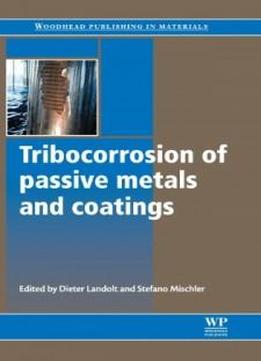
Tribocorrosion Of Passive Metals And Coatings (series In Metals And Surface Engineering)
by Dieter Landolt /
2011 / English / PDF
34.3 MB Download
Tribocorrosion causes the degradation or alteration of materials
through the combined action of corrosion and wear. It limits the
performance and lifetime of installations, machines and devices
with moving parts, and controls certain manufacturing processes
such as chemical–mechanical polishing. The effects of
tribocorrosion are most pronounced on passive metals which owe
their corrosion resistance to a thin protecting oxide film. Most
corrosion-resistant engineering alloys belong to this
category. This book provides an introduction to the
developing field of tribocorrosion and an overview of the latest
research. Part one reviews basic notions of corrosion and
tribology, before presenting the most recent results on the
growth and structure of passive oxide films. Further
chapters discuss tribocorrosion mechanisms under fretting,
sliding and erosion conditions, respectively. Part two focuses on
methods for measuring and preventing tribocorrosion. It includes
chapters on electrochemical techniques, the design of
tribocorrosion test equipment, data evaluation and the
optimisation of materials’ properties for tribocorrosion systems.
Part three presents a selection of tribocorrosion problems in
engineering and medicine. Three chapters address the
tribocorrosion of medical implants including test methods and
clinical implications. The rest of the chapters in part three
examine tribocorrosion issues in nuclear power plants, marine
environments, automotive cooling circuits, elevated-temperature
metal working and chemical–mechanical polishing.
Tribocorrosion causes the degradation or alteration of materials
through the combined action of corrosion and wear. It limits the
performance and lifetime of installations, machines and devices
with moving parts, and controls certain manufacturing processes
such as chemical–mechanical polishing. The effects of
tribocorrosion are most pronounced on passive metals which owe
their corrosion resistance to a thin protecting oxide film. Most
corrosion-resistant engineering alloys belong to this
category. This book provides an introduction to the
developing field of tribocorrosion and an overview of the latest
research. Part one reviews basic notions of corrosion and
tribology, before presenting the most recent results on the
growth and structure of passive oxide films. Further
chapters discuss tribocorrosion mechanisms under fretting,
sliding and erosion conditions, respectively. Part two focuses on
methods for measuring and preventing tribocorrosion. It includes
chapters on electrochemical techniques, the design of
tribocorrosion test equipment, data evaluation and the
optimisation of materials’ properties for tribocorrosion systems.
Part three presents a selection of tribocorrosion problems in
engineering and medicine. Three chapters address the
tribocorrosion of medical implants including test methods and
clinical implications. The rest of the chapters in part three
examine tribocorrosion issues in nuclear power plants, marine
environments, automotive cooling circuits, elevated-temperature
metal working and chemical–mechanical polishing.











